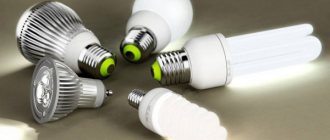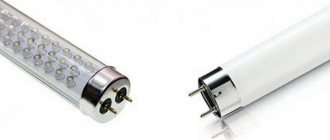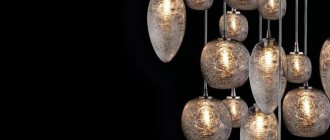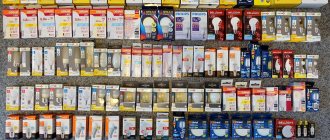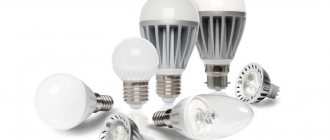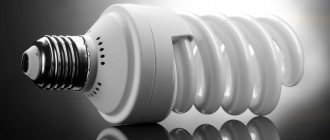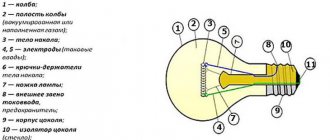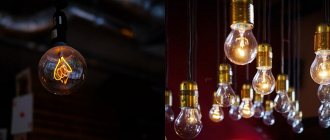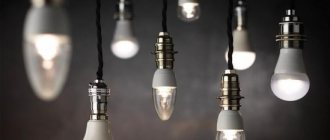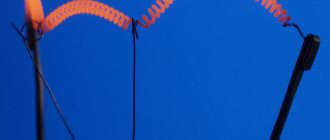Author of the article
Alexander Georgievich Kondratiev
An electrical engineer by training, he worked as an electronics engineer, chief engineer at a food company, and general director of a construction organization.
Electric lamps consume a lot of energy, accounting for about 60% of electricity bills. Therefore, the owner should know how much each light bulb consumes, how utility costs can be reduced, and which lighting devices are best to use.
The industry produces several types of lighting devices:
- Incandescent lamps. These are traditional lamps. which have been used for many years;
- Energy saving or fluorescent lamps;
- LED lighting fixtures. These are new, cost-effective devices that allow you to create various effects.
What is more profitable?
When determining the most economical option, consider the operating time of each type of llama and their cost. We immediately discard the usual ones because they burn out more often and consume more.
But energy-saving and LED ones need to be sorted out. Energy saving - price about 250 rubles, service life 10,000 hours (4.6 years) LED - price about 350 rubles, service life 30,000 hours (14 years with 6 hour use)
For 14 years we will pay for energy-saving ones - 576 * 14 = 8064 rubles + replace light bulbs 3 times. For 14 years for LED ones - 408 * 14 = 5712 rubles.
When calculating, we took average figures, but someone has large production areas with lighting in which only replacing light bulbs will help save decent amounts of money in their wallet.
LED bulbs
The industry has mastered the production of promising LED lamps. Outwardly, they do not differ from ordinary ones.
A driver is installed inside, which lowers the voltage to operating voltage, and a matrix consisting of LEDs. Flask of matte color made of glass or plastic. There is no vacuum or inert gas inside.
Compared to traditional ones, LED light bulbs consume 7 times less energy with the same luminous flux. That is, if we want to maintain the illuminance level comparable to a 100 W lamp, we must purchase a 14 W LED lamp.
It should be taken into account that the industry produces devices of various configurations that have two types of light. Daytime (cold) and warm, close to the spectrum of a traditional incandescent lamp.
In stores, along with conventional lighting devices, flexible LED strips are sold. They can be used to illuminate ceilings and household items, creating unique design objects in the apartment.
In addition, strips can be used as workplace lighting or basic lighting.
Tapes are produced that allow you to reproduce various lighting effects with unique color combinations. Control is carried out using special programmable drivers.
For connection, take into account how much the LED consumes in order to select a power supply. At the same time, the cost of purchasing such lamps is not much higher than the cost of energy-saving ones.
The table below shows the estimated electricity consumption data.
| Lamp with three lighting fixtures, W | Daily consumption, kW | Monthly consumption, kW | Monthly fee, rub. |
| 14 | 0,21 | 6,3 | 25,39 |
| 8 | 0,08 | 3,6 | 14,51 |
| 3 | 0,045 | 1,35 | 5,44 |
It is worth considering that such lamps, if made with high quality, will be almost eternal.
LED lamps: pros and cons
In LED lamps, light is emitted by diodes, so the shape of the plastic “cap” can be any: spherical, candle-shaped... Some time ago, corn lamps were popular - they were so named because of their specific appearance, reminiscent of a real cob.
LED lamps are fundamentally different from fluorescent lamps and have their own advantages for which consumers value them. Which is better, an LED lamp or an energy-saving (fluorescent) lamp? We can understand this by considering the pros and cons of LEDs.
Advantages of LED lamps:
- Reduced energy consumption . LEDs are 9 times more economical than incandescent lamps. So, on average, a 10-watt “LED” corresponds to 80 - 90 W incandescent lamps. By replacing all incandescent lamps in an apartment with LED ones, you can significantly reduce energy costs.
- Durability . LED models can serve their owner from 30,000 to 50,000 hours, which is significantly more than any other type of lighting fixture. However, it is worth noting that such a service life is possible if the light bulb operates in ideal conditions at a temperature of 25 degrees. At lower or higher temperatures, the service life may be reduced by 10 - 15%.
- Maintainability . Unlike other types, LED models can be repaired if they fail (by the way, we have a detailed guide). Often a resistor fails or a cold solder contact appears. In this case, you can unscrew the light bulb and replace the damaged part.
- They don't get warm . During operation, LEDs do not get very hot, so they can be used in structures with stretch ceilings and other “delicate” materials.
- Wide light and color spectrum . The consumer can choose a device with warm, cold, or neutral spectra. In addition, you can choose a light bulb according to the color of the bulb (especially important for decorative lamps).
- "Smart" light bulbs . In the 21st century, so-called “smart” light bulbs appeared, controlled by a mobile device via Wi-Fi. Using your smartphone you can adjust the brightness and color palette. A striking representative of the smart generation of light bulbs is the Xiaomi Mi LED Smart Bulb with the ability to control devices running Andorid OS 4.1 and higher and iOS 8.0 and higher.
Disadvantages of LED lamps:
- High price . On average, LED models cost 8 times more than incandescent lamps.
- LED burnout. The LED tends to burn out (degrade) and gradually lose its brightness. Over 3 - 5 years, the LED loses up to 10% of its brightness.
- Sensitivity to elevated temperature. LEDs do not like high temperatures, which makes them problematic to use in hot rooms, for example, in baths or saunas.
Comparative characteristics of various lamps
It is recommended to take the most popular light sources as an example. Currently, conventional incandescent lamps are still widely used in all spheres of life and activity. Bulbs with a power of 40, 60, 75 W are mainly used, as they are the most economical. Lamps of 100, 150 and 200 W are used much less frequently.
For subsequent comparison, you need to perform a simple calculation, which involves 5 light bulbs of 60 watts each, turned on for 4 hours every day. First, it is determined how much a 60 watt light bulb consumes per hour . As a result of the calculations, the monthly electricity consumption will be: (5 x 60 x 4) x 30 = 36,000 watts or 36 kW. If the cost of one kilowatt is conventionally taken as 3.5 rubles, then the total price of electricity consumed by five light bulbs will be: 36.0 x 3.5 = 126 rubles. That is, for 5 light bulbs over the course of a month, a fairly significant amount accrues. It can be even more if in large apartments or private houses more than 5 lighting devices are used. In addition, the light bulbs themselves can be more powerful.
In order to reduce lighting costs, you need to analyze the operation of lighting fixtures, determine the number of lamps that are turned on unnecessarily, as well as how much electricity the light bulb consumes per hour. If there are no people in the room, the lights should be turned off. It is recommended to use lower wattage bulbs or reduce their number altogether.
Fluorescent lamps
Unlike incandescent lamps, they are a flask filled with an inert gas in which gas-discharge breakdown occurs. As a result, an ultraviolet glow appears. It is not visible to the human eye. However, the phosphor or luminescent coating of the bulb converts it into visible light.
Fluorescent lamps are also called energy-saving lamps. Such devices are five times more economical than traditional ones with the same luminous flux.
We will perform a calculation and comparative analysis of the energy consumption of fluorescent lamps. For ease of comparison, let’s take similar initial data from the previous calculation.
But we will reduce the power by 5 times, since 12 W energy-saving lamps emit a luminous flux equal to 60 W of an incandescent lamp. A 100-watt incandescent light bulb is equivalent to a 20-watt fluorescent light bulb.
And per hour, a 4 W light bulb consumes the same amount of energy as a traditional 20 W light bulb with the same luminous flux. This means that three four-watt devices need to be installed in the chandelier. For ease of comparison, we add the results to the table.
| Lamp with three lighting fixtures, W | Daily consumption, kW | Monthly consumption, kW | Monthly fee, rub. |
| 20 W | 0,3 | 9 | 36,27 |
| 12 W | 0,18 | 5,4 | 21,76 |
| 4 W | 0,06 | 1,8 | 7,25 |
Comparing the results, we see that energy-saving appliances consume less electricity than incandescent lamps. However, such lamps cost 1.5-2 times more than traditional ones. The savings will be noticeable only after a few months.
It should be taken into account that the service life of such electrical appliances is 2-3 times longer than usual. That is, during the operation of fluorescent light bulbs, you will need to replace 2-3 ordinary ones, which will cost more than the price of energy-saving ones.
Thus, energy-saving in terms of per kilowatt of energy consumed and taking into account their cost turns out to be more profitable than conventional ones.
Fluorescent lamps: pros and cons
Fluorescent light bulbs are tubular-type lighting fixtures. In shape they can be elongated oblong or spiral. The latter are more compact and most often used in everyday life. The structure consists of the following elements:
- Base.
- Ballast control device.
- A glass flask (tube) containing a phosphor, as well as mercury and argon vapor.
Advantages of fluorescent lamps:
- Energy consumption is reduced by 60-70% compared to incandescent lamps. At the same time, the light output is much higher.
- Long service life . The average service life of fluorescent lamps is 10,000 - 12,000 hours, while an incandescent lamp of similar light transmission is only 2,000 hours.
- Good light dispersion . In this design, light comes out not from one point (filament), but from the entire surface of the bulb, coated with a phosphor.
- Wide light spectrum . You can choose warm, cool or neutral lighting.
Disadvantages of fluorescent devices:
- Sensitivity to the environment . Luminescent “housekeepers” do not tolerate low temperatures well, so they are not recommended for street lighting. They also do not like moisture, so it is better not to install them in the bathroom or dressing room.
- Sensitivity to voltage changes . A sharp increase in voltage in the network, for example, a short circuit, can damage the device. Also, if the voltage drops by more than 10 - 15% (up to 180 - 190 V), the light bulb may simply not light up. If you have a three-phase power supply, then it is better to place such lamps on a less loaded phase.
- Mercury vapor is hazardous to health . The lamp contains a small amount of mercury vapor inside. If you stay in a room with damaged light bulbs for a long time, you can get poisoned. Therefore, it is better not to store broken lamps at home, but to dispose of them immediately.
